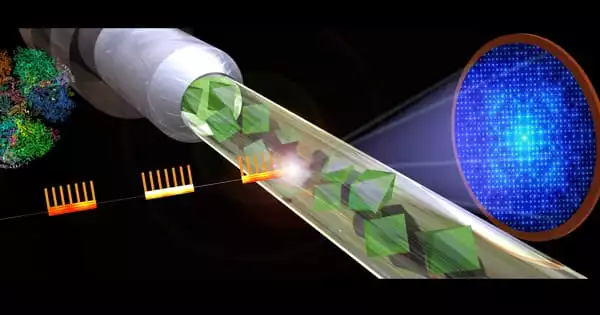A team of researchers has successfully demonstrated nonlinear Compton scattering (NCS) between an ultra-relativistic electron beam and an ultrahigh intensity laser pulse using the 4-Petawatt laser. The innovative approach was the usage of only a laser for electron-photon collisions, in which a multi-PW laser is applied both for particle acceleration and for collision (also called an all-optical setup). This achievement represents a significant milestone in strong field physics, in particular strong field quantum electrodynamics (QED), offering new insights into high-energy electron-photon interactions without the need for a traditional mile-long particle accelerator.
In a groundbreaking study recently published online in the journal Nature Photonics, a team of researchers has successfully demonstrated nonlinear Compton scattering (NCS) between an ultra-relativistic electron beam and an ultrahigh intensity laser pulse using the 4-Petawatt laser at the Center for Relativistic Laser Science (CoReLS) within the Institute for Basic Science at Gwangju Institute of Science and Technology (GIST), Korea. The innovative approach was the usage of only a laser for electron-photon collisions, in which a multi-PW laser is applied both for particle acceleration and for collision (also called an all-optical setup). This achievement represents a significant milestone in strong field physics, in particular strong field quantum electrodynamics (QED), offering new insights into high-energy electron-photon interactions without the need for a traditional mile-long particle accelerator.
Nonlinear Compton scattering requires an electron to absorb multiple laser photons while emitting a single high-energy gamma-ray photon. To observe this phenomenon, researchers approached the “Schwinger limit” — a theoretical laser intensity (2×1029 W/cm2) so strong that it “boils” the vacuum of space-time, for generating matter-antimatter pairs. Since the current record for the highest laser intensity in the world, demonstrated by CoReLS, is still a million times below this threshold, the team employed a workaround: an ultra-relativistic electron beam collided with an ultrahigh intensity laser pulse, exploiting Einstein’s theory of relativity. In the electron’s reference frame, the laser intensity appeared to be about 50% of the Schwinger limit, triggering nonlinear QED phenomena.
Researchers carefully characterized the gamma-ray energy, aided by Monte-Carlo simulations, to ensure that other x-ray and gamma-ray backgrounds did not interfere with the measurements. They verified the gamma-ray signatures against theoretical predictions and compared the experimental results with analytical models and particle-in-cell simulations performed using supercomputers.
The scientists conducted a series of experiments using the CoReLS PW laser. The laser beam was split into two beams, each serving distinct roles. The first beam was focused onto a 5-cm-long gas-filled cell, where it triggered “laser wakefield acceleration” (LWFA) of electrons. In this mechanism of acceleration, electrons “surf” a laser-generated plasma wave, gaining an energy up to 3 GeV — 99.999999% of the speed of light. The second beam was a flash of light focused to a 2-micron diameter (a few % of a hair diameter), lasting only 20 femtoseconds (a femtosecond represents a billionth of a millionth of a second). This beam was directed to collide with the accelerated electrons coming out of the plasma in the gas cell.
Achieving the precise overlap required for the collision, within a few microns and 10 femtoseconds, allowed the laser pulse to “shake” the electrons, which bounced up to 400 laser photons, absorbing them simultaneously. The absorbed energy was then emitted as a single high-energy gamma-ray photon with energy in the range of tens to hundreds of megaelectronvolts.
Researchers carefully characterized the gamma-ray energy, aided by Monte-Carlo simulations, to ensure that other x-ray and gamma-ray backgrounds did not interfere with the measurements. They verified the gamma-ray signatures against theoretical predictions and compared the experimental results with analytical models and particle-in-cell simulations performed using supercomputers. The agreement between the experiment and simulation confirmed the occurrence of nonlinear Compton scattering and allowed the team to deduce the colliding laser intensity by extracting its “fingerprint” from the gamma-ray signals.
Due to the large number of collisions, the resulting gamma-ray beam produced in experiments was 1,000 times brighter than anything previously achieved in laboratories at this energy scale. This breakthrough has potential applications in studying nuclear processes and understanding antimatter production, such as the Breit-Wheeler process for exploring photon-photon collisions to produce electron-positron pairs.
















